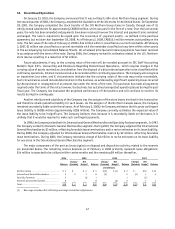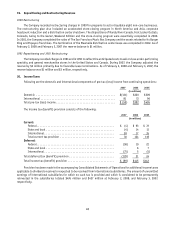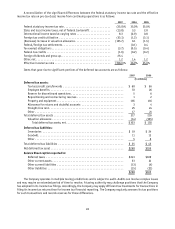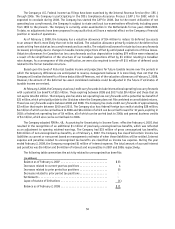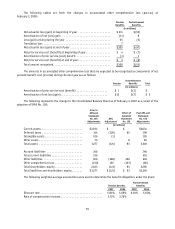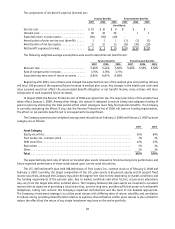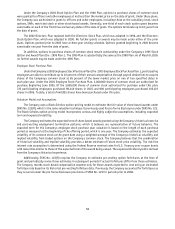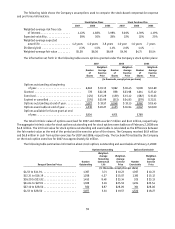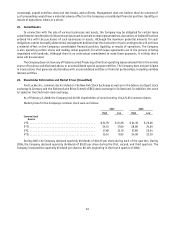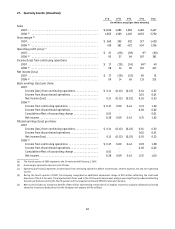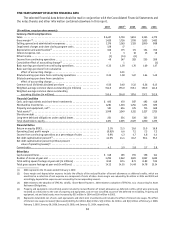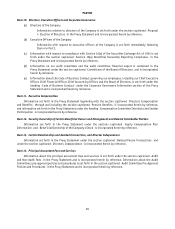Foot Locker 2007 Annual Report Download - page 72
Download and view the complete annual report
Please find page 72 of the 2007 Foot Locker annual report below. You can navigate through the pages in the report by either clicking on the pages listed below, or by using the keyword search tool below to find specific information within the annual report.
56
The components of net benefit expense (income) are:
Pension Benefits Postretirement Benefits
2007 2006 2005 2007 2006 2005
(in millions)
Service cost . . . . . . . . . . . . . . . . . . . . . . . . . . . . . $ 10 $ 10 $ 9 $— $ — $ —
Interest cost ............................. 36 36 36 — 1 1
Expected return on plan assets ............... (56) (56) (49) — — —
Amortization of prior service cost (benefit) . . . . . 1 1 1 (1) (1) (1)
Amortization of net loss (gain) ............... 11 12 13 (8) (10) (12)
Net benefit expense (income) ................ $ 2 $ 3 $ 10 $ (9) $(10) $(12)
The following weighted-average assumptions were used to determine net benefit cost:
Pension Benefits Postretirement Benefits
2007 2006 2005 2007 2006 2005
Discount rate . . . . . . . . . . . . . . . . . . . . . . . . . . . . . 5.66% 5.44% 5.50% 5.80% 5.50% 5.50%
Rate of compensation increase . . . . . . . . . . . . . . . . 3.75% 3.76% 3.77%
Expected long-term rate of return on assets ...... 8.85% 8.87% 8.88%
Beginning with 2001, new retirees were charged the expected full cost of the medical plan and existing retirees
will incur 100 percent of the expected future increase in medical plan costs. Any changes in the health care cost trend
rates assumed would not affect the accumulated benefit obligation or net benefit income, since retirees will incur
100 percent of such expected future increases.
In August 2006, the Pension Protection Act of 2006 was signed into law. The major provisions of the statute have
taken effect January 1, 2008. Among other things, the statute is designed to ensure timely and adequate funding of
pension plans by shortening the time period within which employers must fully fund pension benefits. The Company
is currently evaluating the effect, if any, that the Pension Protection Act of 2006 will have on funding requirements.
The effect on net periodic benefit cost is not expected to be significant.
The Company’s pension plan weighted-average asset allocations at February 2, 2008 and February 3, 2007 by asset
category are as follows:
2007 2006
Asset Category
Equity securities ........................................................ 55%64%
Foot Locker, Inc. common stock ............................................ 1% 1%
Debt securities ......................................................... 42% 33%
Real estate ............................................................ 1% 1%
Other ................................................................ 1% 1%
Total ................................................................. 100% 100%
The expected long-term rate of return on invested plan assets is based on historical long-term performance and
future expected performance of those assets based upon current asset allocations.
The U.S. defined benefit plan held 396,000 shares of Foot Locker, Inc. common stock as of February 2, 2008 and
February 3, 2007. Currently, the target composition of the U.S. plan assets is 65 percent equity and 35 percent fixed
income securities, although the Company may alter the targets from time to time depending on market conditions and
the funding requirements of the pension plan. Due to market conditions and other factors, actual asset allocations
may vary from the target allocation outlined above. The Company believes that plan assets are invested in a prudent
manner with an objective of providing a total return that, over the long term, provides sufficient assets to fund benefit
obligations, taking into account the Company’s expected contributions and the level of risk deemed appropriate.
The Company’s investment strategy is to utilize asset classes with differing rates of return, volatility and correlation
to reduce risk by providing diversification relative to equities. Diversification within asset classes is also utilized to
reduce the effect that the return of any single investment may have on the entire portfolio.



